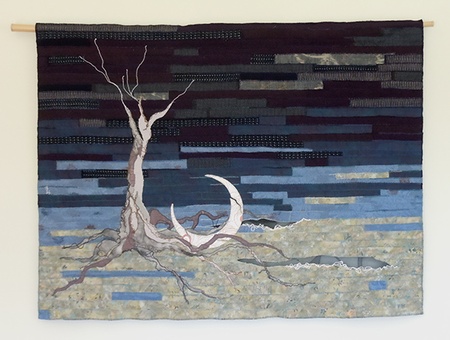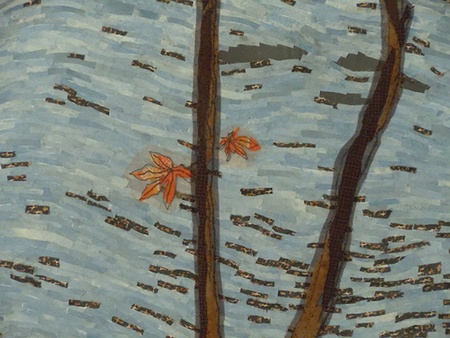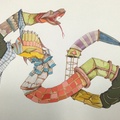When Claremont-based fabric artist Sumi Foley was a child growing up in Osaka, Japan, she often spent the night at her grandmother’s house. Her Obā-san would bring out scraps of old kimono fabric and young Sumi enjoyed touching the silky cloth fragments and admiring their exquisite patterns. She soon learned from her grandmother how to sew and developed a love for this art form. Years later, when she was in her twenties, she stopped by her grandmother’s in time to catch her preparing to throw out piles of old kimonos in a plastic bag. She asked to have them all, and at that moment her journey as a fabric artist began.

"Fallen Moon" by Sumi Foley, 2013; stitched fabric, 29" x 38" | Courtesy of Main Street Gallery, Pomona.
For over two decades now, Foley has cut up pieces of beautiful Japanese kimono fabric and lovingly sewn them together again by hand into textile mosaics, delicate collages that speak of a reconstructed connection to her homeland, her grandmother, and traditions of Japanese beauty and femininity.
In her collage It’s About Time, Foley’s strong spiritual connection to Japan is vividly illustrated. In this work, we see a multicolored patchwork path weaving its way through a dazzlingly red tunnel formed by a series of vermillion wooden torii, the gates that mark the entrance to a Shinto shrine, the abode of Japan’s native spirits or kami. In this case, the shrine is that of the Japanese Harvest God, Inari, who controls the rice harvest and is often represented by fox messengers (a common motif in many of Foley’s earlier works). Here, Foley overlays gate upon gate, decreasing them in size to take our eye deep along the path into the shrine. “When visiting ancient shrines and temples in Japan,” explains Foley, “one experiences a different kind of time that stretches so far back in human history that we become dizzy trying to understand it in modern terms. As we climb uphill through hundreds of red shrine gates, we feel as though we are walking in eternity.” Stitched over these gates in black lines barely discernible from penciled outlines are the wooden gears and stone counter weights of the 16th century clock in the library of the Bonaparte family chalet just over the Rhine in Switzerland. To Foley, the clock represents “the recent, feeble attempt made by humans to somehow regulate the flow of time.” With the title, It’s About Time, Foley reminds us that when we feel that change is needed in our lives, we express this need in terms of time.
In a more recent work, Flow, she depicts russet maple leaves and slender branches floating on the surface of a river. The image alludes to ancient Japanese poetic descriptions of maples tossed about on the Tatsuta River near Kyoto, such as this verse by 9th century aristocratic poet Ariwara to Narihira:
Chihayaburu
Kamiyo mo kikazu
Tatsutagawa
Karakurenai ni
Mizu kukuru to waThe waters of the Tatsuta River
Have been dyed crimson
Such a thing
Is unheard of
Even in the age of the great gods.(author’s own translation)
Because of its poetic associations, the image of maple leaves tossed on the Tatsuta River is a recurring motif in Japanese paintings, ceramics, and even kimono design representing the withering, but often spectacular, beauty of autumn. Using slender fragments of silk, Foley conveys a rhythmic fluidity in the water current as it sweeps the crimson leaves downstream. Though she herself has been carried away to another culture, she implies here a continued strong connection to the literary and artistic traditions of Japan.
Recently, Foley has also been reworking her fragments of women’s kimonos into statements about feminine identity and power. In Fallen Moon (2013), the moon, a symbol of feminine energy in Asian cultures, shown here in its crescent form, has fallen from the sky and is nestling among the roots of a gnarled old tree. The sky, rendered with indigo-dyed Japanese fabric, has been plunged into darkness while the ground and near side of the tree are lit up by the moon’s glow. “Torn” sections of the fabric close to the moon’s landing place suggest a rupturing of the natural realm. “Women have so many responsibilities, and we don’t allow ourselves a chance to rest and recover,” Foley explains. “I wanted to show the moon in a surprising place resting on the ground and recharging its energy.” The upheaval of the natural cosmic order suggested by the grounded moon is somewhat unsettling, but Foley’s delicate treatment of this these implies that there are gentle, feminine ways of shaking up the status quo.

"Separation" by Sumi Foley, 2013; stitched fabric, 31" x 36" | Courtesy of Main Street Gallery, Pomona.
In another recent work, “Separation,” Foley has constructed a wall of red silk bricks and then used thick black stitches to form a huge cracked right down the center of the wall. This metaphoric structure and the title of the work suggest the separation the artist feels from her homeland and its culture, symbolized by delicate white cherry blossoms fluttering on a breeze on the other side. The wall, already apparently crumbling and shaky, as indicated by grayish brown patches and gaps in the bricks, is undoubtedly on the verge of collapse. By shattering this barrier to her other world, Foley seems to be reconstructing the silk fragments of her grandmother’s kimonos into a visual promise never to spiritually, emotionally, or artistically leave her original home.
More of Sumi Foley’s fabric art can be seen here.

"Going Home" by Sumi Foley, 2010, stitched fabric, 18" x 20" | Courtesy of Square i Gallery, Claremont.
*This was an article in the “Asian Accents” series that explores the diverse range of artistic influences from Asia in the arts and culture of Southern California. It was originally published on KCET Artbound on March 26, 2014.
© 2014 Meher McArthur







